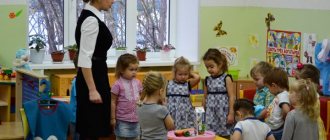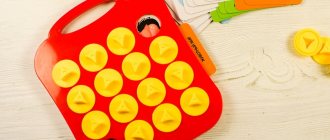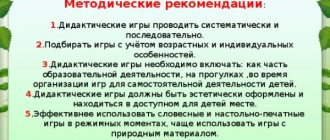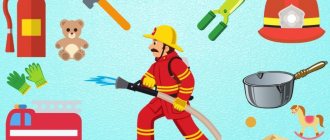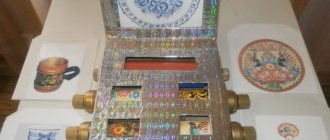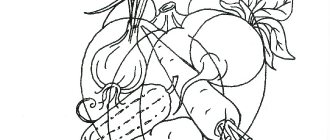Didactic games “Be careful, Baby!” (for children 5-7 years old)
Description of material:
This material will be useful to kindergarten teachers, additional education teachers, and parents of students. These games are aimed at developing in children the skills of careful handling of household appliances and understanding the need to comply with fire safety rules.
Crossword puzzle “Spark the carcass before the fire, avert trouble before the blow”
Target:
Introduce children to objects and phenomena that can cause a fire.
Tasks:
To develop in children basic knowledge about the dangers of playing with flammable objects; instill in children a sense of self-preservation.
Material:
Crossword puzzle on a sheet of A-4 size for each child, felt-tip pens, illustrations: various electrical appliances, candle, matches, fire, sparks, oven, lightning.
Progress of the game:
Educator.
How do you understand the proverb “Spark the carcass before the fire, avert trouble before the blow”? (Children's answers.)
Educator.
Why do fires occur? A crossword puzzle will help us answer this question.
Children sit at the tables on which the crossword puzzle is located.
Children solve a crossword puzzle using illustration clues. Before filling out the crossword puzzle, children's attention is drawn to the word that needs to be guessed by putting the letters in accordance with the numbers.
Horizontally:
3. The house is a glass bubble, and a light lives in it.
During the day it sleeps, but when it wakes up, it lights up with a bright flame. (Lamp)
4. At the rest stop he helped us: he cooked soup and baked potatoes.
It’s good for a hike, but you can’t take it with you. (Bonfire)
6. In the hut there is a hut, in the hut there is a pipe. There was a noise in the hut, a hum in the chimney.
People see the flames, but don’t go to put them out. (Bake)
7. It hangs and is silent, but when you turn it over, it hisses and the foam flies. (Fire extinguisher)
9. The head burns with fire, the body melts and burns
It can melt, but it’s not the ice, not the lantern, but it gives light. (Candle)
10. He shoots fiery arrows, no one will catch them. (Lightning)
Vertically:
1. Only me, only me, I’m in charge in the kitchen, no matter how hard you work without me, you’ll be satiated without lunch. (Electric stove)
2. She only scratched her head on her cramped house.
And immediately - as if the poor thing had not lived, it burned to the ground. (Match)
5. In a linen country, a steamboat floats along a sheet river, now back and forth,
And behind it there is such a smooth surface, not a wrinkle can be seen. (Iron)
8. The whole universe lives in it, but it is an ordinary thing. (TV)
"The Fourth Wheel"
Target:
To develop the ability to compare objects and identify an object that is dangerous to life and health.
Tasks:
• Develop verbal and logical thinking, the ability to classify, compare, generalize, establish cause-and-effect and logical relationships.
• Develop visual perception.
• Develop monologue and dialogic speech.
• Cultivate attentiveness, the ability to accurately follow instructions; determination.
Material:
square cards with images of four objects: those that cause fire, objects that cannot be taken, that require careful handling, square cards the size of one picture
Game content:
Invite the children to look carefully and determine what is drawn in excess, and explain why. In the picture you need to find an image that does not fit the other three.
For example:
Three images belong to the concept of “safe objects”, and the picture with the image of a needle or scissors belongs to the classification “dangerous”, which means the needle is an extra object. Whoever is the first to cover the extra item on the cards correctly wins.
“Fire hazardous places in the apartment”
Target:
To form in children an idea of objects that are dangerous to life and health that they encounter in everyday life.
Tasks:
Promote the development of caution and prudence
Develop logical thinking, attention, and the ability to draw conclusions.
Material:
Approximate diagrams of rooms, signs - dangerous, safe.
Contents of the game:
The teacher offers children an image of different rooms of the apartment: kitchen, children's room, bathroom, etc., in which household items are located.
Educator:
Look carefully at the picture and identify items in it that children can use independently and identify those items that may be dangerous. Place signs near them: “Danger”, “Safe”.
For example:
Washing powder and dishwashing detergent are chemicals, you can get poisoned, we put a danger sign. The winner is the one who places the signs correctly without missing objects.
"The game is a serious matter"
Target:
To give children an understanding of dangerous and safe objects in the world around them.
Tasks:
To develop the ability to realistically assess the possible danger from surrounding objects.
Develop speech activity during the game.
Foster a sense of caution and self-preservation.
Material:
Danger and safety signs, pictures of objects (ball, book, car, doll, builder, album, pencil, pills, iron, matches, lighter, computer, knife, needle, washing powder), boxes with sticky signs: “Danger” , “Safe”, top with arrow.
Progress of the game:
Educator:
You guys have grown big and will soon go to school, what will they call you? (First graders, schoolchildren.)
Educator:
In first grade, many will have to stay home alone. Which one of you did your parents leave at home alone? (Children's answers.)
Educator:
If you've already been alone at home, then you know the safety rules. What dangers might there be at home? (Children's answers).
Educator:
Well done, you noticed very well all the dangers in objects. What items in the house can be considered dangerous? (Children's answers.)
Educator:
Help me choose items to play with when left alone at home. (Children's answers.)
Educator:
Look what I have. What do you think this is? (Children's answers.)
(Playing field with cards, with images of objects, a top with an arrow).
Educator:
We spin the top one by one, take the card that the arrow points to. We carefully examine it and determine which box we will put it in and with which sign. Why?
Children:
The iron is drawn, you cannot turn on electrical appliances - they can cause an electric shock or cause a fire. Box with a dangerous sign.
Educator:
Well done, you and I have identified dangerous and safe items for ourselves.
Didactic game for middle preschool children “Dangerous objects”
Khalameeva O.V.
teacher at MBDOU combined type kindergarten No. 39
The game is designed to achieve positive results in working with children on the basics of life safety, by instilling in each child a sense of responsibility for the ability to handle objects that pose a danger and threat to life.
It helps to solve a set of problems and its goal is to familiarize children with sources of danger in everyday life.
Equipment: a teaching aid in the shape of a flower, each petal depicts an object that children should not touch at all or only under the supervision of an adult. There is a red arrow in the center.
Progress of the game: the teacher invites the children to turn the arrow to one or another picture one by one, and everyone discusses together the dangerous situations that they may encounter at home.
Expected results of working with children: improving the knowledge of pupils about objects that pose a danger when handling them and about dangerous situations that occur in everyday life, at home.
This game is aimed at developing the basics of life safety in the home of pupils. The game is of practical importance in consolidating children’s knowledge about objects that pose a danger when handling them and about dangerous situations that occur in everyday life at home.
The didactic game “Dangerous Objects” helps to give children accessible knowledge about the rules of safe behavior with objects that pose a danger and threat to life, about dangerous situations in everyday life.
The author proposed an original idea for the design of a didactic game: it is presented in the shape of a flower, each petal depicts an object that poses a danger when handling it. Working with the game is simple and convenient; the arrow located in the center of the flower helps to determine what object will be discussed. The use of games when organizing joint or independent activities helps the teacher develop coherent speech and mental processes: visual memory, attention, observation, thinking.
Related materials:
- Didactic games for preschoolers “Emergencies”, “Be careful!”
- Didactic game for middle preschool children “Dangerous objects”
- Didactic game for children of senior preschool age “Object world of Rescue Service 01”
- Didactic safety game for older preschoolers “Home Alone”
- Didactic games for preschoolers “Good and Evil Fire” and “Rescue Service”
Newer articles:
- Didactic games for preschoolers “Emergencies”, “Be careful!”
- From the experience of a teacher “Fairy tale for preschool children “The Three Brave Little Pigs”
- Safety textbook for senior preschool children “Actions in case of fire and flood”
Older articles:
- Didactic game for children of senior preschool age “Object world of Rescue Service 01”
- Didactic safety game for older preschoolers “Home Alone”
- Didactic games for preschoolers “Good and Evil Fire” and “Rescue Service”
- Didactic game for middle preschool children: “Be careful, don’t get burned!”
- Didactic game for preschoolers “The ABC of Safety”
Dangerous items at home
Physical education minute
“Trees have grown in the field”
Trees have grown in the field. It’s good to grow in the wild! (Stretching - arms to the sides.) Everyone tries, Reaches towards the sky, towards the sun. (Stretching - hands up.) Then a cheerful wind blew, The branches immediately swayed, (Children wave their arms.) Even the thick trunks Bent down to the ground. (Bends forward.) Right and left, back and forth - This is how the wind bends the trees. (Tilts left and right, forward and backward.) He turns them, he turns them. But when will there be rest? (Rotation of the body.)
Educator:
Guys, listen and watch the story that happened to the guys who were left alone at home.
“Kolya and Sveta were left alone at home. Mom and dad went to work. For a long time they could not figure out what to do, and then they came up with an idea... ( showing a presentation and discussing situations in it
)" Presentation (slide 1 - children playing on the balcony, slide 2 - children playing with matches, slide 3 - children turn on electrical appliances, slide 4 - children play with water, slide 5 - children sit on the windowsill, slide 6 - children play with tablets, slide 7 - children take a knife, needle, screwdriver, slide 8 - children near the front door, slide 9 - girl plays with her mother's cosmetics)
Educator:
Guys, where do your mothers and grandmothers put their needles, pins, and scissors? Where do dad and grandpa keep their tools? Where do you keep your medications in your house? (Children's answers)
Guys, do you know that all items in the house should have their place not only for order and beauty, but also for safety.
So that you do not forget the rules for handling dangerous objects, I will give you reminders. (familiarization with the instructions)
Educator:
Guys, let's remember the safety rules once again:
— Do not leave electrical appliances on unattended, or even better, do not turn on electrical appliances at all unless necessary.
- Do not play with matches, lighters or turn on gas appliances under any circumstances! Even a spark can start a big fire! Many people could suffer from this.
- Do not take sharp objects - various kitchen utensils, scissors and other similar things not intended for play! You could seriously injure someone or injure yourself!
- You cannot take medications without the permission of adults. Without knowing how to take them, you can get poisoned and end up in the hospital.
- If you are alone at home and the doorbell rings, do not open it for anyone, even if they are people you know.
- Don’t go out onto the balcony and play there, don’t hang over its railing - you might fall.
- Don't sit on the windowsill - you can fall out of the window and get injured.
— Don't forget to close the water tap. Don't play with water in the bathroom. You might forget to turn off the water and cause a flood.

